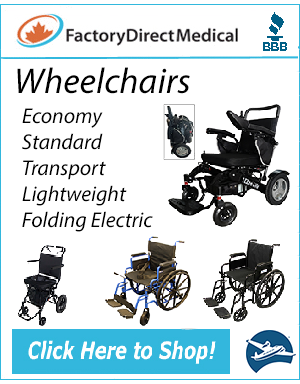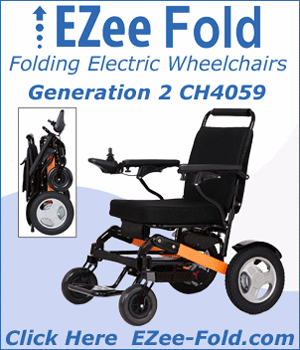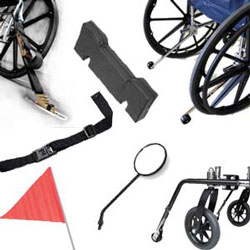
Wheelchair Safety Accessories
Safety in a wheelchair or scooter has to be one of the things that should be foremost in the minds of prescribers and purchasers. A mobility device that isn't safe for the user, or those around them, should be avoided.
In cases where, for the most part, users are safe and competent in the use of their mobility equipment accidents can still happen and the products on this page have been created to minimize the occurrence of specific accidents for everyone's safety.
The mobility equipment safety items below are available as aftermarket items from most wheelchair vendors and while some are specific to certain devices, there may be differences between different models and the images may not be accurate for your mobility device.
Wheelchair Seat BeltsSome people call them safety devices, others call them positioning aids and still others call them restraints. Wheelchair seat belts can be any of these things or all three but I'm not going to classify them here.
Seat belts come in various lengths and are adjustable and are available with four different closures including an auto style buckle, an airline style buckle, a side release buckle (backpack) and a velcro closure. Wheelchair seatbelts do not replace an auto seatbelt and shouldn't be used as such during transportation. |
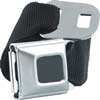 Auto Style 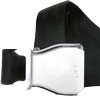 Airline Style 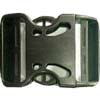 Side Release Style  Velcro Style |
Anti-TippersAnti-tippers are devices attached to the frame of the wheelchair and prevent the wheelchair from tipping over and injuring the user. They can usually be found at the rear of the wheelchair low to the ground between the wheels and intended to prevent rearward tipping however there are style that mount to the front of the wheelchair to prevent forward tipping. Anti-tippers are optional equipment on most manual wheelchairs with the exception of tilting or reclining wheelchairs where they are standard equipment. Users who are always pushed by caregivers rarely require them as the caregiver will prevent the wheelchair from tipping but people who self-propel can be in danger of rearward tipping when climbing ramps or hills on properly balanced wheelchairs as most of their weight is centered over the rear wheels while on level ground. When climbing a hill or slope the center of gravity is transferred behind the rear wheels and when added to the forces created by pushing on the handrims the wheelchair will be come quite tippy. Front tipping is pretty rare and this style of anti-tipper is not very common but there are occasions where the wheelchair could tip forward. Examples of causes of front tipping could be users who rock back and forth in their seat (either voluntarily of involuntarily), a wheelchair that has too much weight centered over the casters will tip forward if it hits an obstacle or possibly a user who tries to pick an item up off the floor in front of the wheelchair by bending forward. While being an obvious safety item, anti-tippers do have a couple of drawbacks. The first is that active users who regularly tip their wheelchairs back on purpose to climb curbs and small obstacles, won't be able to with the rear anti-tippers in place. The second drawback of anti-tippers, whether front or rear style will have difficultly with any type of good sized bump or change in the angle of driving surface. In any most situations where the anti-tippers contact the ground, without the wheelchair actually tipping to make them touch down, will transfer the user's weight off the rear wheel and onto the anti-tippers themselves making the wheelchair unmovable by the user. |
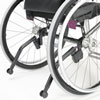 Rear Anti-Tippers  Front Anti-Tippers |
Safety FlagsSafety flags are a really good idea for people who are out on the street and in parking lots on a regular basis, or even occasionally. The wheelchair/scooter user is sitting down and not tall enough to be seen easily by drivers. A flag that sticks six feet into the air above the user will go a long way to catching the attention of any drivers in the area. Granted the driver is responsible for making sure they are not going to hit pedestrians (people using mobility equipment are considered pedestrians) but if the wheelchair/scooter user wants to avoid being hurt, or worse, they had better assume the driver didn't look especially in parking lots. After all, regardless of who is at fault, the wheelchair/scooter user is going to be the victim in any accident and suffer the majority of injury and damage. I used to give all my power wheelchair and scooter users a free flag when they bought a wheelchair from me when I was still in the retail business after having several of my customers hurt. Fifteen or twenty dollars of lost profit was worth keeping my clients safe. Many wheelchair manufacturers offer flags as option when ordering but if money is an issue, any place that sells bicycles will sell you a flag you can mount on your chair for a fraction of the manufacturer's price. |
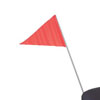 Safety Flag 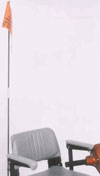 Safety Flag |
Rear View MirrorRear view mirrors are more common on mobility scooters than wheelchairs but aren't a bad idea for power wheelchairs if the user isn't able to see behind them very easily. Same idea and style as a bicycle mirror, they are mounted to the tiller handles of scooters so the user can see what is happening behind them without having to turn their body around to look. They are standard on several models of scooters and usually mounted on both sides but can be ordered as options on all scooters. When mounted on a power wheelchair they will normally be mounted on the arm of the seat but are in danger of being damaged because they usually stick out beyond the footprint of the wheelchair. |
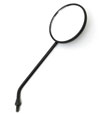 Rear View Mirror |
Upholstered BumpersYou'll see these pieces of upholstered foam pads in nursing homes mostly. They often use them instead of a seat belt to keep their residents sitting safely in their wheelchairs. These pads are shaped to sit across the user's lap and hooking onto the armrests of the wheelchair. The arm rests have to have a downtube of some sort near the front of the wheelchair seat which often means the arms must be full length. They are not much good as a positioning aid as they allow a fair amount of movement |
 Upholstered Bumper Pad |
Wheelchair Tie DownsWheelchair tie downs are not as much wheelchair accessories as they are vehicle accessories, for anyone who transports a wheelchair inside a vehicle however they are an extremely important accessory to have. In many areas it is illegal to transport a wheelchair user in a wheelchair or scooter without a proper tie down system. The tie downs secure the wheelchair/scooter to the van or bus so it won't move around during accidents or even normal driving conditions. Tie downs also provide attachment points for a seat belt to be user by the user so they are held in place during an accident just like any other passenger would be. Wheelchairs and scooters will become missiles in the event of a serious vehicle accident whether or not their is a user in the chair creating a hazard for anyone in the vehicle. Even when the chair is tied down the user must also be secured by a separate belt attached to the vehicle. A seat belt attached to a wheelchair for positioning/restraint is not designed to withstand the stresses of an accident and will probably fail turning the user into a missile even if the wheelchair remains secure. There are two basic types of tie down systems, the strap method which would have to be set up by a care giver and another system that is often referred to as a docking system. Tie Down Strap SystemWith the strap method, four wheelchair tie down straps have to be hooked onto the wheelchair frame and tightened and then the user seatbelt adjusted. To leave the vehicle the seatbelt is undone and the four straps need to be unhooked. Needless to say, most wheelchair users would fine this procedure impossible to do independently. Tie Down Docking SystemWith the "docking system" design, a hook or pin is mounted on the wheelchair that automatically locks onto a mechanism mounted to the floor of the vehicle when the wheelchair is manoeuvred into position. The user seat belt is usually a retractable seat belt mounted in the vehicle which the user can access themselves. To leave the vehicle a switch is used to electrically unlock the wheelchair allowing the user to back out of the floor mechanism. While being fairly expensive, this docking system is really the only practical way for a user to independently lock themselves into the vehicle without assistance. In the event of a power failure the system can be unlocked with a lever mounted to the docking station. |
|



 Online Vendors
Online Vendors  US Online Vendors
US Online Vendors 